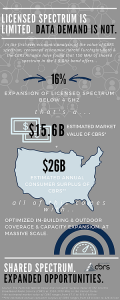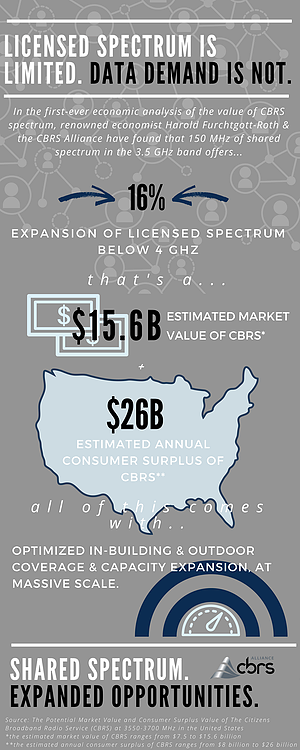

We recently partnered with former FCC commissioner Harold Furchtgott-Roth to conduct the first-ever economic analysis of the value of CBRS spectrum. Harold, who’s now the president of Furchtgott-Roth Economic Enterprises, also held the title of chief economist for the U.S. House Committee on Commerce during the Clinton administration.
The full report is packed with a lot of detail and interesting stats and a thorough analysis of the economic value of CBRS. However, you don’t have to be an economist to understand the resounding message that came out of this research – there is massive value tied to the effective use and sharing of spectrum in the 3.5 band.
We handpicked a few of the key stats to illustrate what “massive” value actually looks like:
-
The estimated market valueof CBRS ranges up to $15.6 billion
-
The estimated annual consumer surplus of CBRS is between $8 billion-$26 billion
-
The estimated net present value of consumers surplusis between $80 billion-$260 billion
For those of us who don’t live and breathe economics, consumer surplus is the difference between the total amount that consumers are willing and able to pay for a good or service, and the total amount that they actually pay. For context, the combined valuation of Uber and AirBnB is around $80 billion; as you’ll notice, $80 billion is on the lower end of Harold’s estimated net present value for CBRS. In addition, Harold’s analysis found that the estimated economic cost of delaying the availability of CBRS is between $10-$20 billion per year.
The report also found that freeing up 150 MHz of shared spectrum in the 3.5 GHz band offers a 16 percent expansion to existing licensed spectrum below 4GHz. It’s difficult to overstate the importance of freeing up even 1 MHz of spectrum for commercial application, let alone 150 MHz! That’s roughly equivalent to the total spectrum that each of the Big 4
U.S. wireless operators have licensed to date!
These numbers begin to illustrate the enormous potential offered by CBRS-based wireless technologies. Traditional wireless solutions are struggling to meet the increasing demands of industrial organizations and enterprises. Organizations such as GE, the Port of Los Angeles and CBRE (Commercial Real Estate Group) are looking to new solutions to future-proof their networks, and the underutilized CBRS band shows promise.
So, what does all this mean?
Great question. In case you’re not a numbers person, here are a few more qualitative, real-life examples of what “massive” value looks like, whether you’re talking about Industrial IoT networks, smart cities, or in-building applications:
-
CBRS could help fill in-building cellular coverage gaps. Energy-efficient glass is known to block cellular signal penetration, and tall buildings can block outdoor signals to their shorter neighbors. While high-frequency spectrum can’t penetrate these blockages, LTE networks in the 3.5 band deployed indoors can, which could result in exponential connectivity improvements for Enterprises.
-
CBRS also presents options for owners of public spaces, such as stadiums, sports arenas, theme parks, and convention centers, to name a few. Private LTE networks powered by CBRS allow venue owners to create high performance networks tailored to their unique needs. For example, entertainment venues supported by CBRS can provide enhanced remote viewing capabilities, improved crowd management solutions, and new opportunities for fan engagement (including AR/VR). In addition, these private networks allow venu
-
e owners to overcome connectivity challenges in high-density areas – such as crowded cities and major sporting arenas – and provide their customers with reliable connectivity without breaking the bank.
-
The CBRS applications for Industrial IoT are vast, and we’ll elaborate on those in future blog posts. For now, one example of CBRS applications for Industrial IoT includes remote monitoring of critical assets utilizing the predictability and security that comes with LTE solutions leveraging CBRS spectrum. High-bandwidth data analytics and processing (also known as “edge analytics”) is also enabled by CBRS.
The full report from Furchtgott-Roth Economic Enterprises is available for download here. If you’re interested in learning more about CBRS and what the CBRS Alliance is doing to help shape tomorrow’s wireless networks, be sure to connect with us on Twitter and LinkedIn, or drop us a line at info@cbrsalliance.org.
